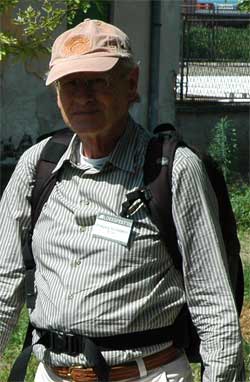LOESSFEST'09 | Aug. 31st – Sept. 3rd, 2009 |Novi Sad-Serbia
Interglacial Complex and Soil Cluster
Schirmer, W.1
1Heinrich-Heine-Universität Düsseldorf, Universitätsstr. 1, 40225 Düsseldorf
Solcomplexes
 Interglacial soils may exist as soil clusters (solcomplexes), which are in addition
accompanied by interstadial soils. KUKLA (1969) recorded from Červený kopec
close to Brno that each of the last nine interglacials is developed as a soil complex.
In 1970 he showed that these solcomplexes correlate to clusters of warm peaks of
deep sea sediments which nowadays is common knowledge.
Interglacial soils may exist as soil clusters (solcomplexes), which are in addition
accompanied by interstadial soils. KUKLA (1969) recorded from Červený kopec
close to Brno that each of the last nine interglacials is developed as a soil complex.
In 1970 he showed that these solcomplexes correlate to clusters of warm peaks of
deep sea sediments which nowadays is common knowledge.
The deposits separating the single fossil soils within a solcomplex represent loess
or loess derivates. This means warm periods of different kinds (interglacials as well
as interstadials) are separated by shorter cold periods, so-called breviglacials (Schirmer
1999). These breviglacials may be accompanied by erosional processes that commonly
are smooth enough to save parts of the whole solcomplex. This contrasts to
the long cold periods, the euglacial periods, during which redeposition and erosion
is strong enough to remodel the morphology to a far extent.
It is also known that spreading of loess deposits that shows climate development
more differentiated occurs preferably in downslope or hollow position. In
addition those locations tend to remain more protected from erosion than other
morphological positions.
Mutilation of solcomplexes
Consequently, in case we find an isolated fossil Bt horizon within a loess section it represents a mutilated interglacial complex. This mutilation may result from different processes:
- The mutilation may be an optical phenomenon in case that the elsewhere spread solcomplex has simply been converged to optically one soil (soil convergence).
- In other cases during breviglacial periods erosional processes removed some limbs of the solcomplex formed shortly before (syn-solcomplex truncation). May be, erosion removes the whole early solcomplex developed up to now (syn-solcomplex erosion).
- A third case is the postdepositional truncation of the solcomplex after its very end at the beginning of the next euglacial period (post-solcomplex truncation). Also here the whole solcomplex may be eroded (post-solcomplex erosion).
Rhine loess record
The Rhine loess record shows four well differentiated solcomplexes each of an individual character. All three above mentioned cases of their mutilation occur with these solcomplexes. The solcomplex corresponding to the OIS 5 interglacial complex, the Rocourt Solcomplex, shows four luvisols, three humus zones and stagnic soils. Disregarding the stagnic soils, from depression to peneplain due to soil convergence and syn-solcomplex erosion, the solcomplex shrinks from a thick seven-membered soil cluster to a small three-membered soil band with a luvisol and two humus zones.
The solcomplex allocated to OIS 7 interglacial complex, the Erft Solcomplex, merges from a six-membered solcomplex in depressions to a five-membered at the slope due to synsolcomplex truncation. Post-solcomplex truncation and erosion is observed frequently in case of all solcomplexes.
The interstadial solcomplex appointed to OIS 3 interstadial complex, the Ahr Solcomplex, should also be inserted into this group of solcomplexes. Though it is not an interglacial solcomplex it should be treated as an early stage of an interglacial complex that could not fully develop (SCHIRMER 2002). The largest vertical spread of this solcomplex exhibits eight calcic cambisols at the Schwalbenberg south of Bonn. Laterally it reduces in places up to one soil (e. g. Lohne Soil) by convergence, syn-solcomplex truncation and also postsolcomplex truncation. This initial solcomplex of OIS 3 points to the fact that the last glacial undoubtly is biparted into two separate euglacial periods. Thus, the last glacial ought to be biparted into an OIS 4 glacial and a OIS 2 glacial - the real Weichselian or Würmian glacial - separated by the Ahr Interstadial Complex (Schirmer 2002).
Simulation of solcomplexes
Solcomplexes, however, may also be simulated. During periods of euglacial loess deposition enormous reworking and erosion activity produces deeply carving unconformities. By subdividing a loess stack, evidencing these discordances is as important as recognizing fossil soils. Due to those discordances luvisols of different interglacial periods may lie in tight neighbourhood simulating sol complexes. Thus, large walls to be cleaned are necessary to follow fossil soils as well as discordances, which both are proper testimonies for traces of former landscape surfaces.
Another case of simulating solcomplexes is soil divergence in contrary to soil convergence.Soil divergence happens when soil formation of a warm period is interrupted by an event that covers the soil with a rock deposit, e. g. volcanic rock, flood deposit, colluvium, talus deposit, debris flow deposit. After this event soil formation continues. Finally, both soils framing the event belong to the same warm period and thus simulate a solcomplex.
Soil convergence and soil divergence
Soil convergence happens, in case soils of different warm periods (interglacials, interstadials) merge to form optically one soil.
Soil divergence happens, in case soil formation of one and the same warm period is interrupted by any interlayer of rock (hard rock or soft rock) and continues on top of this interlayer.
It is also known that spreading of loess deposits that shows climate development more differentiated occurs preferably in downslope or hollow position. In addition those locations tend to remain more protected from erosion than other morphological positions.



